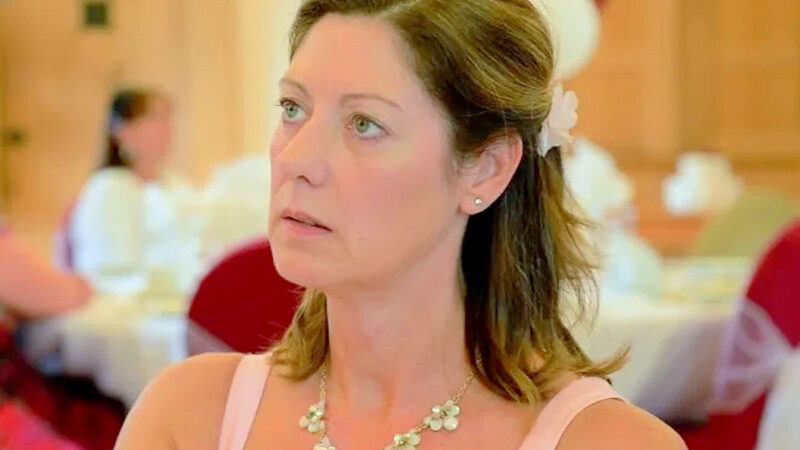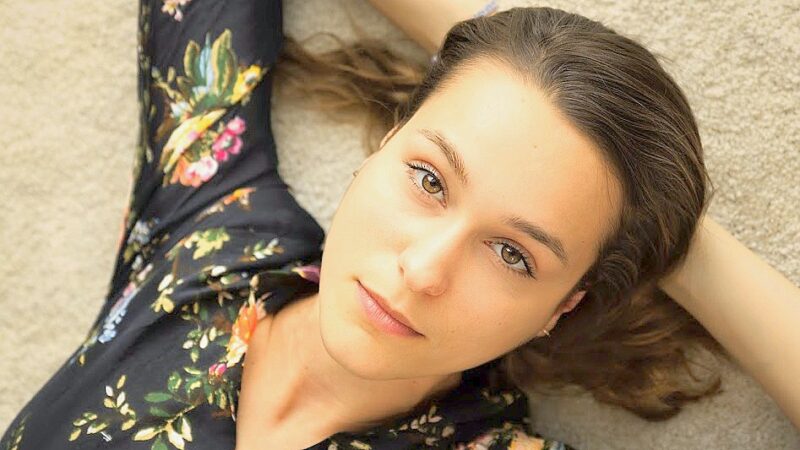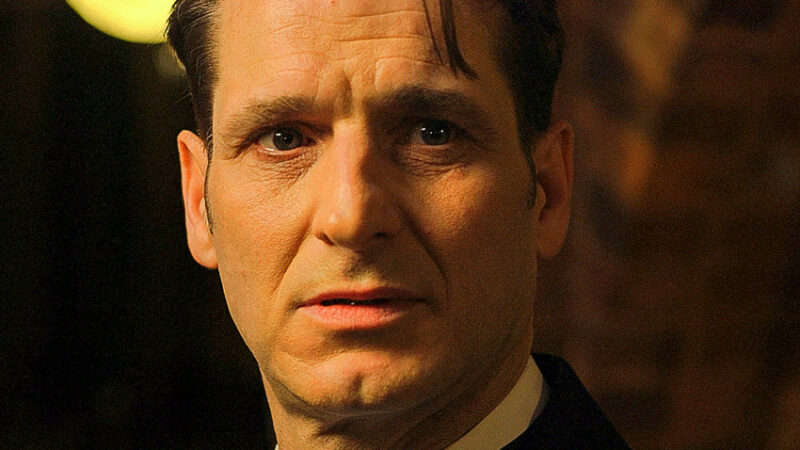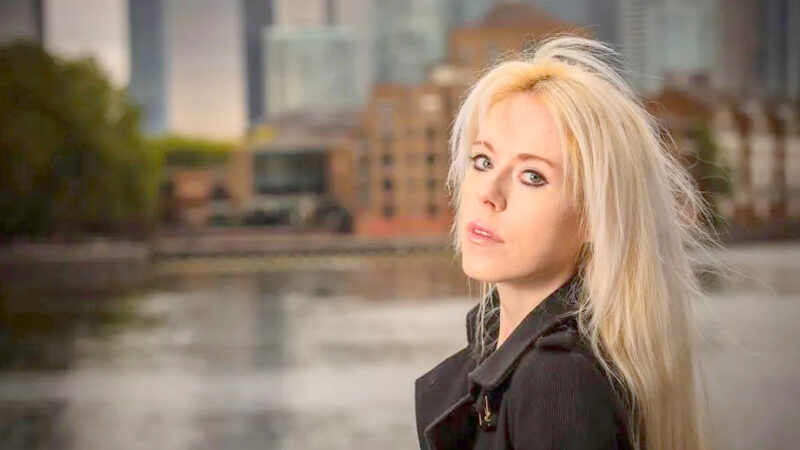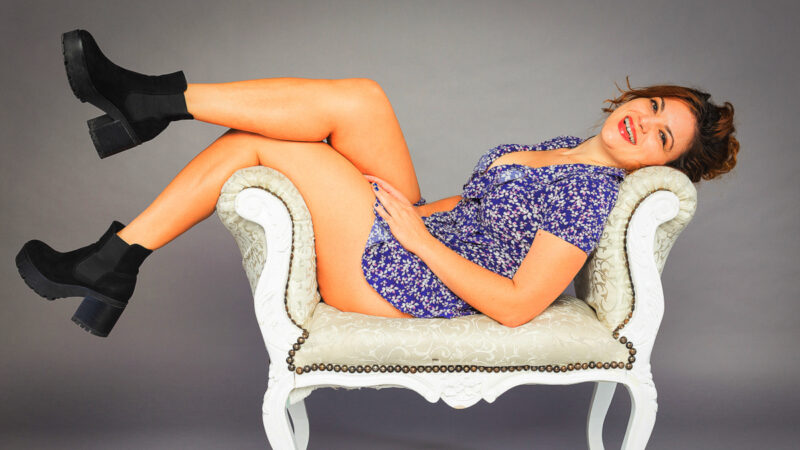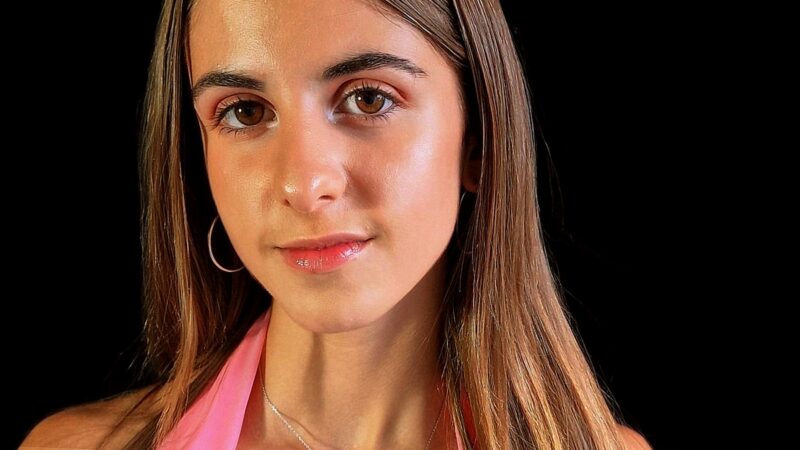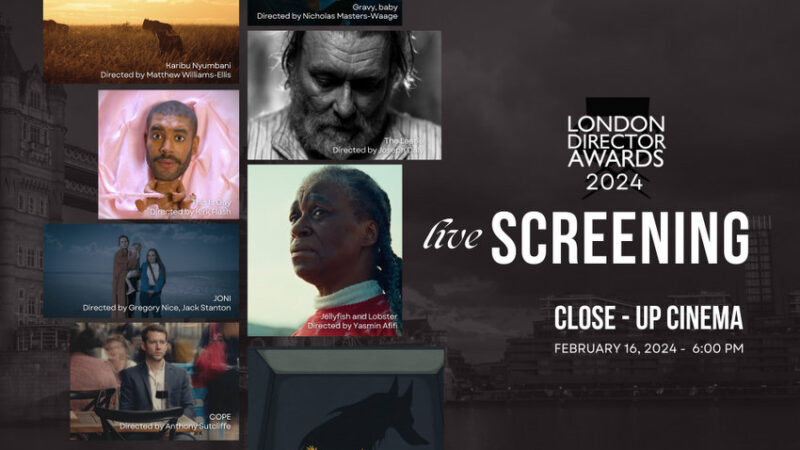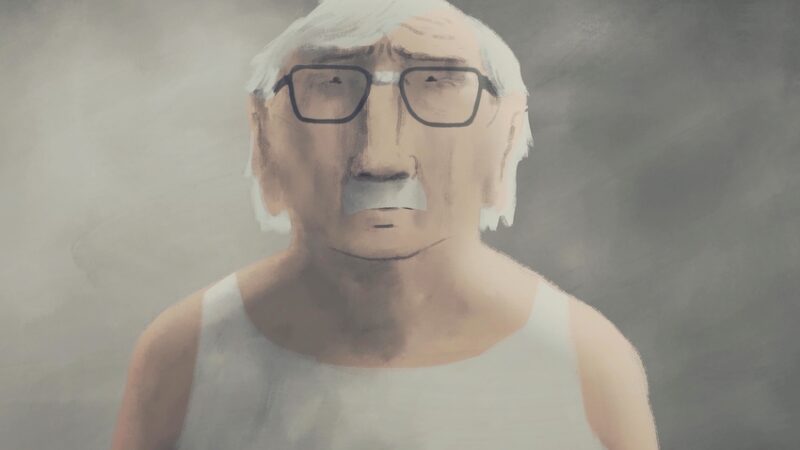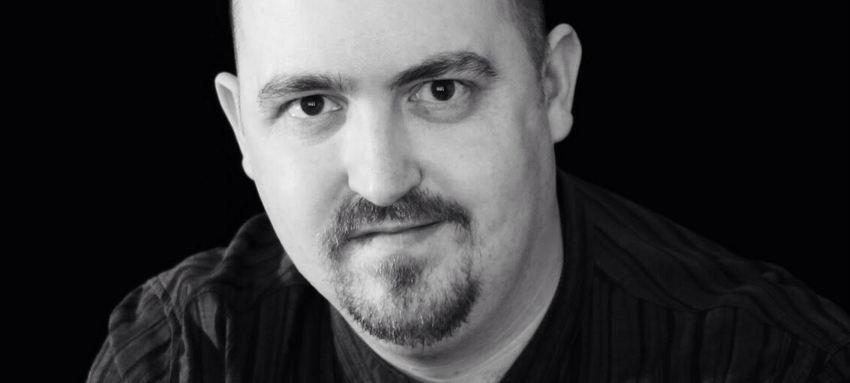
“Dead Meet” is a twenty minute action-comedy about a lonely assassin called Cleo going on a date and having to juggle both business and pleasure when her target and her date are in the same pub. There’s a bit of black comedy in the situation- think “Grosse Point Blank”- and some Hong Kong inspired action sequences. It’s been doing the rounds on the festival circuit for the last nine months or so and the response has been great. Francesca L White, our lead, has also won a couple of awards for her performance in it, so that’s been amazing!
indieactivity: Give a background of your personal experience with the story, writing, production and marketing
Daniel J. Brant: Some of the very first things I ever shot and edited way back in the days of Hi8 and mini DV were action sequences- fight scenes and chases and gunfights, all the fun stuff- but somewhere along the way, but by the time I was studying film at uni I had started focusing more on drama and more serious genres of filmmaking. But I’ve always loved action movies, so with this project I wanted to return to shooting action because I felt it was something I could do well.
Case Study: The making of Daniel J. Brant’s ‘Dead Meet’
When looking for a premise, I wanted something that lent itself to a bit of comedy and a steady rise in tension, and I was inspired by the film “Grosse Pointe Blank” to have an extraordinary character, a professional assassin, in an ordinary but socially nerve-wracking situation like a date. I felt that was a good basis for some situational comedy and character moments- the usually cool and calm assassin has to deal with small talk and date anxiety! Action-wise, I knew that the only things we could pull off on a minimal budget were hand-to-hand fights and gun battles so I focused on having a couple of sequences which we could pre-visualise and prep fully. Really try to do the best we could with the resources we had.
indieactivity: Did you start writing with a cast (You or any) in mind?
Daniel J. Brant: Not really. They say that half a director’s job is casting the right actors and I knew that if I couldn’t find someone suitable to play Cleo, the project was dead in the water. There would be no point in making it if I was going to have to compromise too much on that role and dilute the action scenes. So I just wrote the script and the character as I saw them and then went through CastingCallPro (now mandy.com) looking for female actors with a background conducive to nailing the sort of action scenes I had in mind. And bizarrely, it was kind of easy… I think some part of my brain was optimistically hoping that some undiscovered Michelle Yeoh or Zhang Ziyi style physical performer would appear and I could cast them as Cleo, but the more realistic part of me knew that I would probably have to reign in my ambitions and shoot round a less capable actor.
‘Small, but feisty’ Actress Francesca Louise White on Her Stage & Screen Career
But, with Francesca L White I didn’t have to! She was actually the only person I contacted about the role mainly because she was the only actress on the site that I could find that had a stunt reel! She’d worked on fight scenes before, she trains in Jeet Kune Do and she had a background as a dancer- which was ideal because, in my experience, fight scenes are less about martial technique and more about timing, co-ordination, rhythm, positioning and expression and dancers are much more used to thinking in these terms so they have a better chance of performing this sort of Hong Kong style action. Francesca is also a very capable actress which fortunately meant I wasn’t going to have to make the choice between casting a martial artist who couldn’t act or an actor who couldn’t fight (which is what you often have to do with action films). I lucked out and got both!
Dean Williams (Anderson) was Francesca’s suggestion- she was working with him on another film and recommended him. Dean’s an experienced stunt performer and martial artist and he has an eclectic knowledge of martial arts movies and action choreography, so for someone like me who’s also been training in martial arts since I was a teenager, I can just say that I’m looking for a Thai-style kicking technique or I want a bit of choreography like the scene in “The Prodigal Son” and he knows what I mean! It’s a joy working with him!
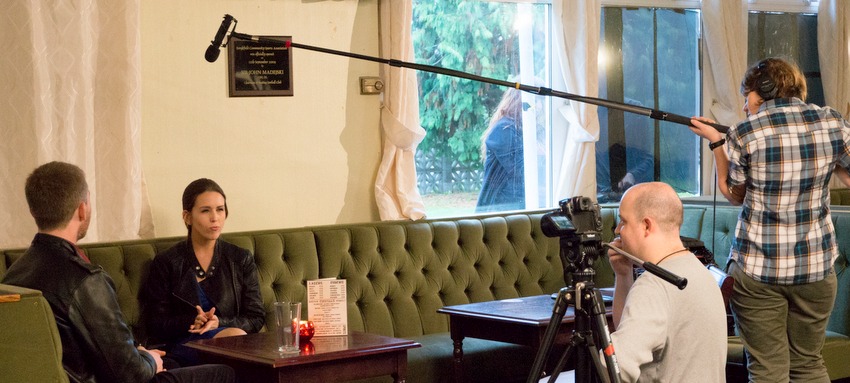
Dead Meet BTS Francesca Louise White, Reuben Williams and Daniel J. Brant
Reuben Williams was a last-minute replacement- the actor I originally cast had to drop out and Reuben stepped in to the role of Ryan, Cleo’s date, at short notice- and he did a great job. He basically has to play the straight man for most of the film, but be likeable enough for both Cleo and the audience to fall for him, which is a tough balancing act to get right. Richard Usher was a recommendation of Graeme (one of our Sound Recordists) and he has this rich speaking voice which I knew would sound great as the voice of Charlie. As a fun cameo, he’s also the jogger in the fluorescent jacket in the opening scene. Both Reuben and Richard are great improvisers so their scenes have some great comic touches as a result.
indieactivity: How long did you take to complete the script? (Do you have a writing process?)
Daniel J. Brant: “Dead Meet” took a couple of months to write and went through about six or seven major drafts. I don’t really have a set writing process- I just start with what I have scribbled down as notes and then jump right in. For instance, the script I’m writing at the moment doesn’t even have a fully developed story yet, I’m just writing the scenes that I see a little clearer in the hope that doing so will help me flesh out the rest of the project. Those scenes probably won’t find their way into the final script- it’s all just exploration at this point. I think Quentin Tarantino once said that he often starts a script by putting two characters in a room and forcing them to talk to each other just to see what happens and where it goes and I quite like that idea.
The other thing I often do is write intentionally lame and bare bones scenes if I know something has to happen at this point in the script but have no idea what to write. For instance, this might be the scene where the heroes have to put aside their differences and work together but I have no idea how that’s going to work just yet, so instead I write a scene with two lines of dialogue: “we should put aside our differences and work together” and “yes we should” and move on. It’s complete crap, but it’s something on the page. And once you’ve written the scenes you know or are enthused about, you’ll have a much better idea about what can go in the problem scene and you can go back and write it properly. Writing lame placeholder text just saves you staring at a blank screen with writer’s block because it allows you to move on to something else.
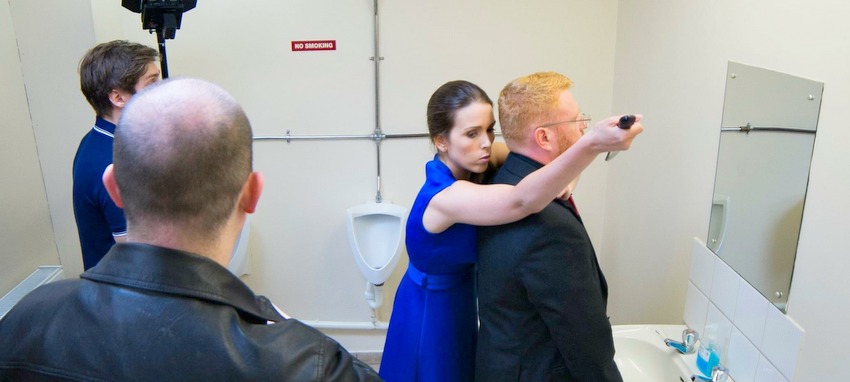
Dead Meet BTS Francesca Louise White, Dean Williams, Daniel J. Brant and Dom Ellis, Full Circle Photography
indieactivity: How did you develop ‘your film’?
Daniel J. Brant: “Dead Meet” went through a number of iterations as I tried to work out what the story was and who the characters were. In fact, in the first version of the script, Cleo was male! I changed it because I have this theory that most characters aren’t defined by their gender, race or even their age- which means you can change these elements without affecting the central plot and perhaps end up with something more interesting. In this case, I think it was because we see strong male characters in action films all the time but when we do see female action roles, they tend to be either overly masculine (like Vasquez in “Aliens”) or overly sexualised (like Trinity in “The Matrix”).
Very rarely do you get a female lead in an action movie that’s allowed to be a woman without some kind of reference to her sexuality. Just look at the difference in the characterisation of Black Widow in the Marvel movies- in “Iron Man 3” she’s very heavily sexualised, wears tight trousers and every character (including Pepper Potts) responds to her attractiveness- it’s the defining element of the character in this film. But by the time of the first Avengers movie, she’s being judged on her own merits and skills and doesn’t seem to be there as fan service for an audience expecting titillation. She gets some emotional scenes, some good one-liners and fight scenes that aren’t just there to emphasise her figure wrapped in spandex.
By the same token, we wanted to show the character of Cleo in a non-sexualised way, so although she’s wearing a dress, it’s because she’s on a date and that makes sense for the story. There are no slow tilt shots to emphasise her figure or shots that objectify the character. I think it’s important to show that you can have a strong female character without making that strength her sexuality.
indieactivity: How was it financed?
Daniel J. Brant: I had a tax refund and decided to put it into making a film. It wasn’t a huge amount of money so we had to prioritise things like production design, location hire and catering as well as paying people’s transport expenses.
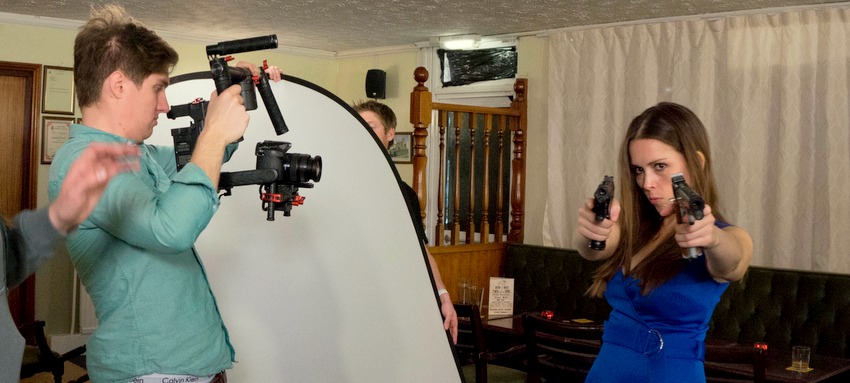
Dead Meet BTS Dom Ellis gets the hero shot of Francesca Louise White with the Ronin
indieactivity: Is there anything about the independent filmmaking business you still struggle with?
Daniel J. Brant: Finding funding is always difficult. I’ve had to self-fund all my previous projects because unless you’re making something commercially viable and manage to find someone willing to back it (in which case, they’ll rightfully want a large slice of the pie and a controlling interest in the film), there aren’t many other options. I mean, there are crowd-funding platforms, but you need a large personal following or something based on an existing property to make that viable. Crowd funding can be a great way to reach an audience and spread the word, but it relies on you having a project that that audience wants to see come to fruition. If it’s just your friends and family donating, it’s kind of a waste of time because once you’ve tapped them the first time, they’re not likely to donate to your next project. Unless you’ve got a rich uncle, of course!
And this lack of funding causes a secondary problem- that you can’t afford to pay people for their work. There’s always a lot of talk about unpaid work in this industry, but I think if it’s a non-commercial short film that’s never going to make any money, then I think it’s okay to treat it as an unpaid collaboration, as long as everyone involved knows that’s what it is up front. Obviously, if is commercial and you do have money, then you should pay people, that goes without saying. And if you’re not paying, you can’t really expect to get industry pros, but if the project’s good, the script’s good and they have faith in you, then you might just get some very talented people on board. People who are looking for opportunities to prove themselves. But even then, you should still provide catering, pay people’s expenses and give them promotion and reel material- a respected cast and crew is a happy and productive cast and crew after all.
indieactivity: How long was your pre-production?
Daniel J. Brant: “Dead Meet” had a protracted pre-production process primarily because we had issues finding locations. We didn’t have much money, so I set most of the film in a location I thought we could easily get- a pub. But we soon realised that pubs weren’t actually that easy to film in, mainly because they’re open every day from mid-morning till late! We also needed to find a pub bathroom to film the fight scene in and I don’t know if you’ve spent much time in pub bathrooms, but you wouldn’t want to pee in them, let alone fight, fall and film in them! We wound up using a community centre bar for the pub location and a village hall men’s room for the bathroom but it took several months to find both of those.
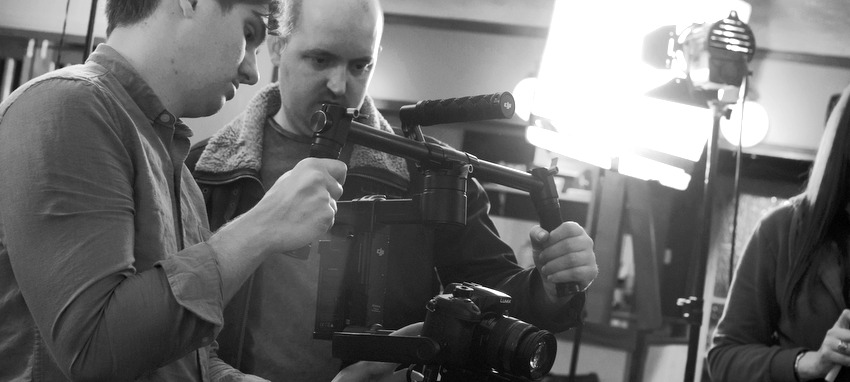
Daniel and Dom check playback on the Ronin
The plus side to all this extra pre-production time was that I could storyboard the film from start to finish, something I don’t always get the chance to do. I find that storyboarding helps me work out how I’m going to cover the scene and how it’s going to cut together. And that allows me to be more efficient and potentially cut corners on set if need be- if I know I’m not going to use a certain angle, then there’s no point shooting it. Cutting corners isn’t exactly the most professional way of doing things, but in the low budget world, everything counts!
indieactivity: What was your rehearsal process and period?
Daniel J. Brant: After Francesca L White (Cleo) and Dean Williams (Anderson) were cast, I felt it was a good idea to find out what we could do with the action and what we couldn’t. So we drove up to Birmingham where Dean is based and hired out a gym space for the day. Dean and Francesca then trained together and tried out some choreography and I shot some video so we could see what worked and what didn’t. And Francesca just kept on surprising us with how quickly she picked things up!
Dean’s an experienced martial artist and stunt coordinator so we started gradually at first, but after Francesca nailed the techniques we were throwing at her, we kept on raising the bar and she kept meeting it! She really throws herself into the action and because she has a solid background of Jeet Kune Do and various styles of dance, we were able to do some fairly intricate choreography in the bathroom fight. We managed a few more rehearsal days like this, often piggybacking on the choreography sessions Dean was leading for the feature film he was working on at the time, so we could get everyone together.
As for dramatic rehearsals, we didn’t really get much of a chance. Rehearsals are a great way to work out the details of a performance, set the blocking and devise business for the actors during the scene and I personally love rehearsals. I think they’re invaluable- it gives the actors a chance to explore their characters and it gives me a chance to steer that experience if I have something in mind or create stuff with them if I don’t. Sometimes you go through the script, sometimes you improvise… it’s an exploratory time really. And it’s always worth doing if you can.
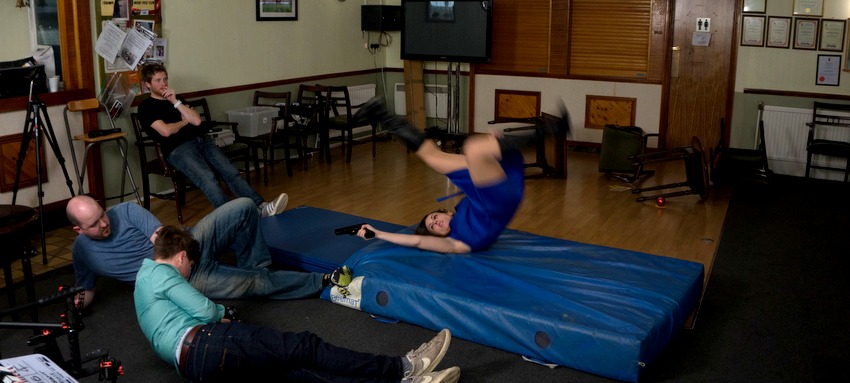
Dead Meet BTS Francesca Louise White does all her own stunts, Daniel J. Brant Dom Ellis and Graeme Rawson
I tend to disagree with directors and actors who say they don’t want to rehearse because it takes way their spontaneity. After all, you’re going to shoot more than one take, aren’t you? And that spontaneity’s gone after the first take. Ultimately, a good actor is able to experience something again and again and make us feel like it’s the first time every time so you lose nothing by rehearsing, but have everything to gain. Sadly, we didn’t get any rehearsal time before the shoot because Reuben was a last-minute replacement, so he and Francesca had to rehearse between camera set-ups and in the downtime on set.
indieactivity: You shot the film in days. How long were your days?
Daniel J. Brant: “Dead Meet” was shot in seven days with loads of pick-ups here and there- five days in the bar, one in the village hall bathroom and one near the river for the sniper scene. On the surface, the shoot days were actually pretty reasonable 9-6 affairs because we had to be out of the locations at a certain time. In practice though, that was rarely the case! We were shooting during the day, but the film takes place at night, so we had to black out the windows in the community centre bar and draw the curtains to maintain the illusion. So every morning, we were putting black packing wrap over the windows with a paint roller and gaffer tape and then taking it down at the end of every shoot day because the location didn’t want it there when the bar was open in the evenings. That stuff took about an hour to do every morning, so I’d get there early and have most of it done by the time the rest of the cast and crew started to arrive.
indieactivity: Did the tight shooting schedule make it harder or easier? How did it affect performances?
Daniel J. Brant: Like with most indie films, time is the second thing you’re likely to have very little of and sometimes you just have to run with it and move like crazy to get everything done. On the final day of shooting in the bar, we were running out of time and shot a lot of Francesca and Reuben’s gunfight dialogue while other crew members were packing up around us! Fortunately, by this point Francesca and Reuben were in sync and had a chance to run the scene a few times between set-ups, so I don’t think it impacted performances that much. And luckily, Dom Ellis our DoP is pretty speedy with setting up shots and lighting everything, so we were able to move at a comfortable speed and still get what we needed.
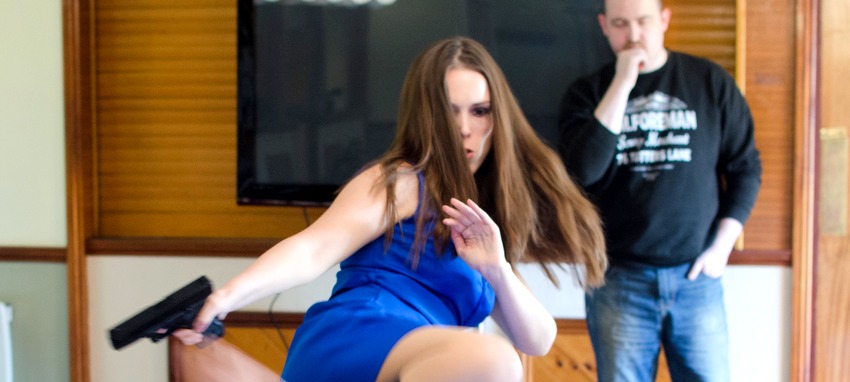
Dead Meet BTS Francesca kicks stuntman Chris McGlynn
indieactivity: How much did you go over budget? How did you manage it?
Daniel J. Brant: The film was made for £1200 (£100ish over my tax refund budget) which is absolutely nothing in the grand scheme of things! All that money went on hiring the locations, buying a few key costume pieces and props, feeding everyone and paying travel expenses. We didn’t hire any equipment- Dom the DoP, Graeme and Cassie the sound recordists and I pooled the kit we had between us and used that. I think a lot of indie films get fixated on kit and wind up hiring stuff in the hopes it’ll make their film better and their budget balloons as a result.
It’s really not worth it because an audience doesn’t care what camera or lenses or lights you used. They care about the story, the performances and the world that’s being shown to them, so they’re the things you need to invest your resources (both time and money) in- stuff your audience can actually experience. Unless there’s a very good reason to hire something in, just use the kit you have available to you. Whatever you can borrow or fudge together for the shoot. And then spend your budget keeping your people happy and your production values high.
indieactivity: How important is marketing? Do you think a project can make any dent without it these days?
Daniel J. Brant: Having a good marketing plan is so important. In today’s media-saturated world, if you want people to see your flick, you really have to work at it. In the past, that meant spending money on advertising, but now you can do a hell of a lot for free. Use social media, reach out to websites and blogs, engage with your audience in forums and groups. Know who your audience is and target them, engage them about your film while you’re making it so that they feel connected with it when you send them the Youtube or Vimeo link.
Even simple things like having a good film poster is often overlooked… So many filmmakers just take a still from the film, some cool shot that the DoP’s really proud of, slap a title on it and a few festival laurels and hope for the best. But that doesn’t really sell the film to an audience. Have a look at how studios market their films- if you don’t have famous faces to hang your film on (and if you’re reading this, you probably won’t!), you need to appeal to your audience’s curiosity. Give them something memorable in the poster, something that hooks them, makes them wonder what the film’s about while making the tone and genre clear enough for them to know they might enjoy it. Make it memorable.
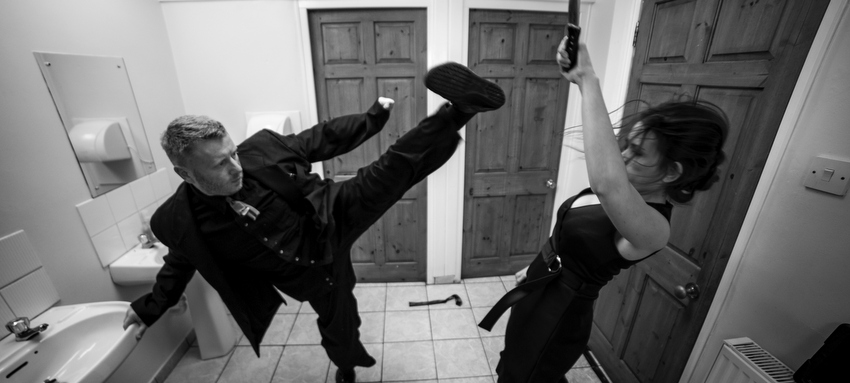
indieactivity: What was the experience like of working with such a small shooting crew (?)?
Daniel J. Brant: The great thing about working with a small crew is that everyone has ownership of their work. On a big production with a big team, someone on the crew might feel like a small cog in a big machine- necessary but not pivotal. On a smaller project with a smaller crew, their role is bigger and they have a bigger impact on the film. This means they’re more likely to voice their ideas and get involved in the decisions, whereas on a bigger shoot, there’re more people in that hierarchy that you have to go through.
As a director, I like collaborating. I like having everyone bring ideas to the table. I’ve never been one to hold onto auteur theory or the idea of a director’s “vision”- filmmaking’s a collaborative process and a good director knows when to field ideas from everyone and when to push for what they want. If you’ve got a small crew, there’s a much tighter working relationship and a sense of trust that develops.
indieactivity: The film looks stunning. How did you get such a good look when shooting so fast?
Daniel J. Brant: A lot of this is down to Dom Ellis, the DoP. We shot on his Panasonic GH4 because the image was great and the small form factor lent itself to handheld and gimbal work in the action scenes. For the latter, we used a Ronin M, which worked quite well for the 3D camera moves we planned and we had a simple handheld rig for shooting in the bathroom which allowed Dom to follow the action quicker than he could’ve on the stabiliser.
The GH4 also allowed us to shoot some 96fps slow motion (albeit in HD) which was great for the sort of speed changes I wanted in the action scenes. Everything else was shot in UHD- that way we could reframe or stabilise a little in post if we needed to and deliver a nicer HD image when we downscaled the final film.
Dom and I pooled our lighting resources for the film and used a mix of Arri tungsten lights and LED panels for the bar scenes. Because the location didn’t look all that pub-like, we couldn’t go for the aesthetic I originally wanted, so Dom made the most of what we did have and kept the date scenes grounded while amping things up for when the fists and bullets started flying.
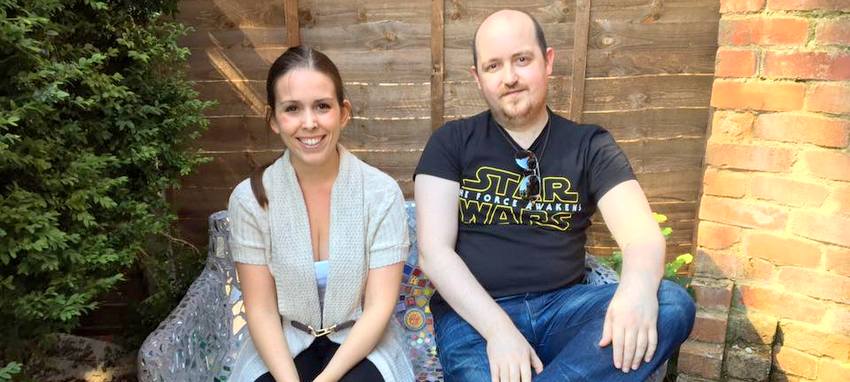
indieactivity: Did you look at rushes? On what format?
Daniel J. Brant: Aside from a few shots- usually the gimbal moves or stunt moments- I didn’t request playback all that often on set. Partly because it slows things down, but also because it can come across as egotistical. I like to ask the DoP, the soundie, the actors… did they think it was a good take? If they say yes, particularly the DoP, then I elect to trust their judgement. So much of directing is people management and this sort of thing can really help build trust on set. That way, if I do ask to see playback at any point, they’ll know I have a good reason.
We backed up the memory cards on set with a laptop so technically I could’ve gone through the rushes after every shoot day, but I didn’t. On previous projects, I’ve actually cut scenes together after we wrapped for the day so I knew if we needed to re-shoot or pick-up any extra shots, but I didn’t feel the need on “Dead Meet.” I think I just gave the rushes a quick skim-through to make sure we had everything and then went to bed! In all honesty, if you have to choose between checking your rushes and getting enough sleep, I’d prioritise the kip! Knowing you have everything in the can is one thing, being behind on sleep and running on empty is another!
indieactivity: What were the advantages and disadvantages in the way you worked?
Daniel J. Brant: I think the biggest advantage to the way I work is also the biggest disadvantage. I tend to work from the edit backwards, trying see the film edited in my head before I shoot it and create my shot lists and storyboards from that vision. This can make things very efficient because I’m only shooting what I need, but it can also create problems if we need to change things in post because there just isn’t enough variety in the footage to enable that. That’s why I tend to be my own editor- if I cut corners when shooting, I’m the one that has to deal with it in post. Over the years I’ve tried to shoot more coverage and give myself or another editor more to work with and that’s largely worked out well, but when things get tight and we have to move fast, I fall back on this pre-visualisation method and cut corners like crazy. So that’s a massive disadvantage as well.
I’m also trying to be a more visual director. A lot of new filmmakers are very well-versed when it comes to cinematography and creating a look for a film, but I’ve always focused on the actors and the performances and I want to pay more attention to the visual storytelling in my work. The ability to show not tell would improve my films no end, so that’s something I want to focus on with future projects.
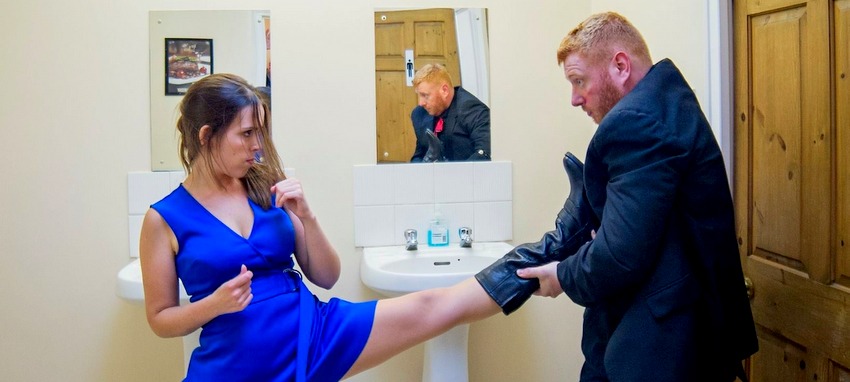
Dead Meet BTS Francesca Louise White and Dean Williams, Full Circle Photography
indieactivity: So how did you shoot the action scenes?
Daniel J. Brant: I’m a big action movie fan so I wanted to do the best I could with the action sequences in spite of our limited resources. Action scenes were actually the first things I ever shot and edited when I started to get into filmmaking as a teenager, so I had a bit of experience and wanted to prove myself and make something of a point about the way other filmmakers shoot action.
Most directors adopt the now-ubiquitous shakycam style for action scenes, full of jump cuts and disorientating close-ups… and in my opinion they really shouldn’t. They justify it by saying it reflects the intensity and confusion of a real fight… but they don’t actually want a real fight- they want a movie fight! With cool choreography, great stunts and exciting visuals. The first Bourne film started the trend, but as the series went on the style became more pronounced and more chaotic and soon the imitators were doing it even more because they think it makes the scene exciting. But it’s not exciting for an audience when they can’t see what’s going on, it’s nauseating. What you really want to do is have controlled movement with the camera, keep the audience orientated and showcase the skill and technique on display. Keep the intensity and energy in the performances not the filmmaking.
Also, I think a lot of filmmakers- including top tier professionals- make the mistake of shooting action scenes the same way as they do dialogue scenes, using coverage. They’ll shoot a master of the whole scene or a big chunk of it, then they’ll go in for over-the-shoulders or hip shots, grab their close ups, any special shots they want and then hand the whole lot over to an editor to turn it into something. But not only does this result in a lack of shot variety it also means most of your angles aren’t selling all the techniques, meaning you have less usable footage in the end. But it seems to be the way action scenes are shot in the west- primarily because it gives more power to the editor and studios are all about having options in post.
However in the east, particularly Hong Kong, they choose the camera angle first and then choreograph the action with that angle in mind, because certain moves and techniques look better or worse or stronger or faster from certain angles and with certain lenses. Each shot is designed to showcase a certain part of the choreography or story, the camera moves with the action and each edit point flows seamlessly into the next (meaning the last move of one shot is the first move of the next, allowing you to cut invisibly on action). This means you have to be aware of things like the 180 degree rule, the 30 degree rule and the effects of camera movement in order to pick your shots properly.
For people like Yuen Wo Ping, Lau Kar Leung and Sammo Hung, they can make this stuff up on the fly and it cuts smoother than Barry White carving out soft scoop ice cream, but generally, you need to know how the scene will edit together before you shoot it. This obviously limits the creative options in editing to a “when to cut” rather than a “what to cut to” which is why a lot of session editors hate it. But it’s better for the performers because they only have to concentrate on a handful of moves at one time and it’s better for the audience because it results in a continuity of movement you don’t get when shooting coverage.
indieactivity: What else have you got in the works?
Daniel J. Brant: I’ve got a couple of micro shorts which I should be directing over the summer. I like shooting micro shorts- they’re smaller and more manageable but they also give you the chance to try new things without risking a bigger, more expensive project. I’m also writing a short ghost story script I’m aiming to shoot in the autumn and a sci-fi action piece that should be a return to what we attempted with “Dead Meet.” If it goes well, I aim to use it as a pitch film to see if I can get funding to develop it as a feature, so that will be a challenge all unto itself!
Follow Daniel J. Brant on Social Media
Website
IMDb
Facebook
Twitter
YouTube

